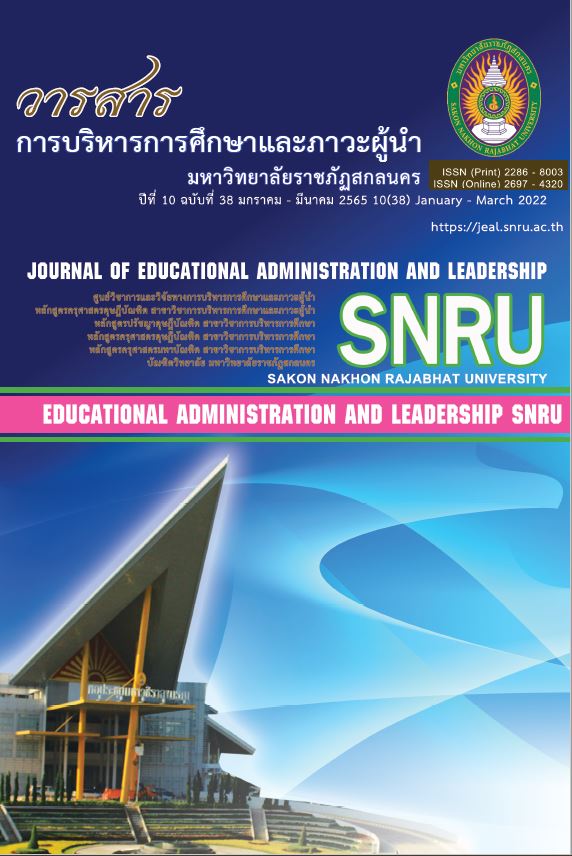

ปัจจัยการบริหารที่ส่งผลต่อประสิทธิผลของโรงเรียนขนาดเล็ก สังกัดสำนักงานเขต พื้นที่การศึกษาประถมศึกษาในจังหวัดนครพนม
Administrative Factors Influencing Effectiveness of Small Sized Schools under the Nakhon Phanom Primary Educational Service Area Office
ผู้แต่ง
อรอุมา ไมยวงค์, ศิกานต์ เพียรธัญญกรณ์, เยาวลักษณ์ สุตะโคตร
Author
Onuma Sripratoomwong, Sikan Pienthunyakorn, Yaovalak Sutacort
บทคัดย่อ
การวิจัยครั้งนี้มีวัตถุประสงค์เพื่อ ศึกษา เปรียบเทียบระดับปัจจัยการบริหารและระดับประสิทธิผลของโรงเรียนขนาดเล็ก สังกัดสำนักงานเขตพื้นที่การศึกษาประถมศึกษาในจังหวัดนครพนม จำแนกตามสถานภาพการดำรงตำแหน่ง ประสบการณ์ในการปฏิบัติงานและสำนักงานเขตพื้นที่การศึกษาที่สังกัด รวมถึงการหาความสัมพันธ์และหาอำนาจพยากรณ์ ปัจจัยการบริหารที่มีต่อมีประสิทธิผลของโรงเรียนขนาดเล็ก และหาแนวทางพัฒนาปัจจัยการบริหารที่มีผลต่อประสิทธิผลของโรงเรียนขนาดเล็ก กลุ่มตัวอย่างที่ใช้ในการวิจัย คือ ผู้บริหารโรงเรียน และครูผู้สอนในโรงเรียนขนาดเล็ก สังกัดสำนักงานเขตพื้นที่การศึกษาประถมศึกษาในจังหวัดนครพนม ปีการศึกษา 2563 จำนวน 320 คน การสุ่มกลุ่มตัวอย่างใช้การสุ่มแบบแบ่งชั้น (Stratified Random Sampling) จำแนกเป็น ผู้บริหารโรงเรียน จำนวน 80 คน และครูผู้สอน จำนวน 240 คน เครื่องมือที่ใช้ในการวิจัย เป็นแบบสอบถามประมาณค่า 2 ด้าน คือ ด้านที่ 1 ปัจจัยการบริหารของโรงเรียนขนาดเล็ก มีค่าอำนาจจำแนกอยู่ระหว่าง .703 - 877 และมีค่าความเชื่อมั่น เท่ากับ .942 ด้านที่ 2 ประสิทธิผลของโรงเรียนขนาดเล็ก มีค่าอำนาจจำแนกอยู่ระหว่าง .758 - 889 และมีค่าความเชื่อมั่น เท่ากับ .946 สถิติที่ใช้ในการวิเคราะห์ข้อมูล ได้แก่ ความถี่ ร้อยละ ค่าเฉลี่ย ส่วนเบี่ยงเบนมาตรฐาน วิเคราะห์ข้อมูลโดยใช้ t-test, F-test (One-way ANOVA) ใช้ค่าสหสัมพันธ์อย่างง่ายของเพียร์สัน (Pearson’s product-moment correlation) และการวิเคราะห์การถดถอยพหุคูณแต่ละขั้นตอน (Stepwise multiple regression analysis)
ผลการวิจัย พบว่า
1. ปัจจัยการบริหารและประสิทธิผลของโรงเรียนขนาดเล็ก โดยรวม อยู่ในระดับมาก
2. ปัจจัยการบริหารและประสิทธิผลของโรงเรียนขนาดเล็ก ตามความคิดเห็นของ ผู้บริหารโรงเรียนและครูผู้สอน โดยรวม ไม่แตกต่างกัน
3. ปัจจัยการบริหารของโรงเรียนขนาดเล็ก ตามความคิดเห็นของผู้บริหารโรงเรียน และครูผู้สอนที่มีประสบการณ์ในการทำงานแตกต่างกัน โดยรวม มีความแตกต่างกันอย่างมีนัยสำคัญทางสถิติที่ระดับ .01 ส่วนประสิทธิผลของโรงเรียนขนาดเล็ก โดยรวมไม่แตกต่างกัน
4. ปัจจัยการบริหารของโรงเรียนขนาดเล็ก ตามความคิดเห็นของผู้บริหารโรงเรียน และครูผู้สอน ที่ปฏิบัติงานในเขตพื้นที่การศึกษาแตกต่างกัน โดยรวม มีความแตกต่างกันอย่างมีนัยสำคัญทางสถิติที่ระดับ .05 ส่วนประสิทธิผลของโรงเรียนขนาดเล็ก โดยรวม ไม่แตกต่างกัน
5. ปัจจัยการบริหารและประสิทธิผลของโรงเรียนขนาดเล็ก โดยรวม สัมพันธ์กันทางบวกอย่างมีนัยสำคัญทางสถิติที่ระดับ .01
6. ปัจจัยการบริหารของโรงเรียนขนาดเล็ก ด้านทรัพยากรทางการศึกษา ด้านการติดต่อสื่อสาร ด้านภาวะผู้นำ และด้านโครงสร้างองค์การ มีอำนาจพยากรณ์ประสิทธิผลของโรงเรียนขนาดเล็ก โดยรวม อย่างมีนัยสำคัญทางสถิติที่ระดับ .01 โดยมีอำนาจพยากรณ์ประสิทธิผลของโรงเรียนขนาดเล็ก ได้ร้อยละ 71.90 และมีความคลาดเคลื่อนมาตรฐานของการพยากรณ์ เท่ากับ ±.15082
7. แนวทางพัฒนาปัจจัยการบริหารที่ส่งผลต่อประสิทธิผลของโรงเรียนขนาดเล็กที่ควรได้รับการพัฒนา จำนวน 4 ด้าน ได้แก่ 1) ภาวะผู้นำ ผู้บริหารควรเป็นผู้สุภาพเรียบร้อย บุคลิกภาพดี เป็นผู้นำและผู้มีองค์ความรู้ 2) การติดต่อสื่อสาร ควรใช้โซเชียลมีเดียในการติดต่อสื่อสาร และมีแผนการดำเนินงานที่มีเป้าหมาย มีการติดต่อสื่อสารระหว่างโรงเรียนกับบ้านอย่างชัดเจน 3) โครงสร้างองค์การ ควรแบ่งโครงสร้างองค์การออกเป็น 4 ฝ่ายอย่างชัดเจน ปฏิรูปโครงสร้างองค์การให้ทันสมัย ให้ทันต่อการเปลี่ยนแปลงในศตวรรษที่ 21 และ 4) ทรัพยากรทางการศึกษา ควรดำเนินการโดยขอรับการสนับสนุนจากภาคส่วนต่าง ๆ จัดหาสื่อ วัสดุ อุปกรณ์ อาคารสถานที่ที่มีความพร้อมต่อการปฏิบัติงานมีแหล่งเรียนรู้ที่เอื้อและเหมาะสมต่อการจัดการเรียนการสอน
Abstract
This research aimed to compare the levels of administrative factors and the effectiveness of small sized schools, as perceived by participants, classified by position, work experience, and the Educational Service Area Office affiliation, to determine the relationship, and to identify the predictive power of administrative factors influencing the effectiveness of small sized schools under the Primary Educational Service Area Office (PESAO) in Nakhon Phanom Province. The sample, obtained through stratified random sampling, consisted of 80 school administrators and 240 teachers, yielding a total of 320 participants working under the PESAO in Nakhon Phanom Province in the 2020 academic year. The research instrument was a set of questionnaires containing two aspects: Aspect 1-the small sized schools’ administrative factors with the predictive power ranging between .703 and 877 and a reliability of .942; Aspect 2 -the small sized schools’ effectiveness with the predictive power ranging between .758 and 889 and a reliability of .946. Statistics for data analysis were frequency, percentage, mean, standard deviation. Data were analyzed using t-test, One-Way ANOVA, Pearson's product-moment correlation coefficient, and Stepwise multiple regression analysis.
The findings were as follows:
1. The administrative factors and the effectiveness of small sized schools were at a high level overall.
2. The administrative factors and the effectiveness of small sized schools as perceived by participants were not different overall.
3. The administrative factors of small sized schools as perceived by participants with different work experience differed at the.01 level of significance, whereas the overall effectiveness of small sized schools showed no difference.
4. The administrative factors of small sized schools as perceived by participants with different Educational Service Area Office affiliation as a whole were at the .05 level of significance, whereas the overall effectiveness was not different.
5. The administrative factors and the effectiveness of small sized schools had a positive relationship at the .01 level of significance overall.
6. The administrative factors of small sized schools in terms of educational resources, communication, leadership, and organizational structure had the predictive power to the school effectiveness at the .01 level of significance with the predictive power of 71.90 percent and the standard error of estimate ± .15082.
7. The guidelines for developing administrative factors influencing the effectiveness of small sized schools needing improvement consisted of four aspects: 1) Leadership; administrators should have polite manners, good personality, be leaders and possess a body of knowledge; 2) Communication; administrators should use social media for communication and create operational plans with a clear goal. The communication between schools and families should be effectively established; 3) Organizational structure; administrators should clearly divide organizational structure into four departments, reform the organizational structure into a modern structure, and keep up with the changes of the 21st century, and 4) Educational resources; administrators should seek support from various sectors, supply medias, materials, equipment, and building infrastructure ready for operations, and provide conducive and suitable learning resources for teaching and learning management
คำสำคัญ
ปัจจัยการบริหาร, ประสิทธิผลของโรงเรียนขนาดเล็กKeyword
Administrative Factors, Effectiveness of Small Sized SchoolNotice: Undefined variable: dataSet in /var/www/html/ArticleView.php on line 116
Notice: Trying to access array offset on value of type null in /var/www/html/ArticleView.php on line 116
บทความทุกบทความเป็นลิขสิทธิ์ของ
Notice: Undefined variable: dataSet in /var/www/html/ArticleView.php on line 116
Notice: Trying to access array offset on value of type null in /var/www/html/ArticleView.php on line 116
เท่านั้น
กำลังออนไลน์: 49
วันนี้: 8,554
เมื่อวานนี้: 24,433
จำนวนครั้งการเข้าชม: 994,952
อาคารบัณฑิตวิทยาลัย ชั้น 2 ตำบลธาตุเชิงชุม อำเภอเมือง จังหวัดสกลนคร 47000
โทร/
แฟกซ์ 0-4297-0093
บรรณาธิการ: รองศาสตราจารย์ ดร.ไชยา ภาวะบุตร
ติดต่อ/สอบถาม: นายธีรเวทย์ เพียรธัญญกรณ์
โทร: 0-4297-0093